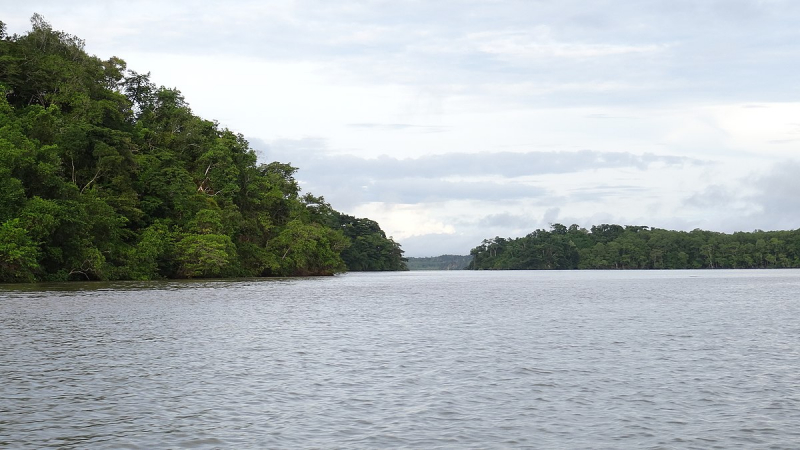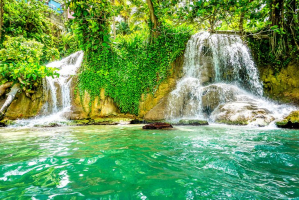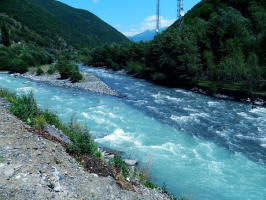Top 5 Longest Rivers In Panama
Panama is bordered by the Caribbean Sea to the north and the Pacific Ocean to the south. It features an extended S form, with an 800-mile (1,290-kilometer) ... read more...Caribbean coastline and a 1,060-mile (1,700-kilometer) Pacific coast; nevertheless, a line drawn from the Costa Rican border in the west to the Colombian border in the east would only reach 480 miles (770 km). From the mouth of the Necategua River on the Caribbean coast to the mouth of the Chepo River on the Pacific coast, the shortest distance across the isthmus is roughly 30 miles (50 kilometers). In the list below, Toplist has compiled the longest rivers in Panama.
-
The Tuira River is one of the longest rivers in eastern Panama's Darién Province. It empties into the Bay of San Miguel in La Palma, the province's capital. It is Panama's greatest river, and one of its tributaries, the Chucunaque River, is the country's longest river. Modern usage includes rivers that are multi-channeled, intermittent, or ephemeral in flow and channels that are practically bankless.
Tuira River, Spanish Ro Tuira, or Tuyra, is a 106-mile-long (170-kilometer) stream in eastern Panama. It begins in the Darién highlands (Serrana del Darién) and runs south-southeast, then north and west via El Real de Santa Mara, where the Chucunaque River joins it, and finally northwest to La Palma on the Gulf of San Miguel (Pacific Ocean). Above its mouth, it is navigable for about 75 miles (120 kilometers). The Chocó Indians live in a tropical rain forest that receives more than 80 inches (2,000 mm) of annual rainfall and has no discernible dry season. Come here and have a wonderful experience!
Length: 230km

en.wikipedia.org 
pinterest.com -
Chagres ranks 2nd on the list of the longest rivers in Panama. The Chagres River, in central Panama, is the largest river in the Panama Canal's watershed. The river is dammed twice, and the two lakes that result—Gatun Lake and Lake Alajuela—are critical to the canal's and water system's operation. The river's normal path is northwest to its mouth in the Caribbean Sea, but its waters flow south through the canal's locks into the Gulf of Panama. As a result, the Chagres are unique in that they drain into two different oceans.
The upper Chagres River, its watershed, and the watersheds of several tributaries are all part of the Chagres National Park, which was formed in 1985 to safeguard the environment and water flow into the canal. Because these rivers provide 45 percent of the canal's total water, the lake is an important portion of the canal zone's watershed. The lake, which reaches a maximum elevation of 76 meters (250 feet) above sea level, can hold one-third of the canal's yearly water requirements for the locks' functioning. Because Lake Alajuela is not on the navigational route, it has fewer water level limitations than Gatun Lake. The reservoir's water is also utilized to create hydroelectric power and provide fresh water to Panama City.
Length: 193 km

tourismpanama.com 
archaeology.org -
Sixaola River ranks 3rd on the list of the longest rivers in Panama. The Sixaola River is a river in Costa Rica's southern Limón Province. It runs northeast of Sixaola from the Cordillera Talamanca to the Caribbean Sea. The La Amistad International Park encompasses the river's headwaters. The river forms part of the border between Costa Rica's Limón Province and Panama's Bocas del Toro Province.The river between Guabito, Panama, and Sixaola, Costa Rica, was bridged by an ancient railroad bridge that collapsed in 2017. Pedestrians going between Costa Rica and Bocas del Toro utilized this bridge as a border crossing between Costa Rica and Panama. This bridge has been demolished. A new binational road bridge is being built adjacent to the existing railway bridge and is scheduled to open in 2020. It will be the conclusion of Costa Rica's National Route 36 and Panama's Route 1001. Sixaola is where Route 36 comes to an end. Guabito, Panama located directly over the river from Sixaola.
Length: 146 km

blogs.worldbank.org 
cbn.com -
Chucunaque River is one of the longest rivers in Panama. It is a tributary of the Tuira River in the Darién Province. It is the longest river in Panama. Chucunaque River is situated nearby to Quebrada El Purgatorio, and north of Quebrada Uruseca. Small natural watercourses are sometimes called rivulets, but a variety of names—including branch, brook, burn, and creek—are more common, occurring regionally to nationally in place names. Arroyo and (dry) wash connote ephemeral streams or their resultant channels. Tiny streams or channels are referred to as rills or tunnels.
The Chucunaque Rive is nourished by precipitation, direct overland runoff, through springs and seepages, or from meltwater at the edges of snowfields and glaciers. The contribution of direct precipitation on the water surface is usually minute, except where much of a catchment area is occupied by lakes. River water losses result from seepage and percolation into shallow or deep aquifers (permeable rock layers that readily transmit water) and particularly from evaporation. The difference between the water input and loss sustains surface discharge or streamflow. The amount of water in river systems at any time is but a tiny fraction of the Earth’s total water; 97 percent of all water is contained in the oceans and about three-quarters of freshwater is stored as land ice; nearly all the remainder occurs as groundwater.

regenwald.org 
atlasobscura.com -
The Guariviara River is a river in Panama. It drains into the southeast shore of Chiriquí Lagoon. Guariviara River is situated northwest of Río Manantí, and northeast of Quebrada Caño Marcolino. Water is constantly cycled through the systems of land ice, soil, lakes, groundwater (in part), and river channels, however. In The Guariviara River, the discharge of rivers to the oceans delivers to these systems the equivalent of the water vapor that is blown overland and then consequently precipitated as rain or snow—i.e., some 7 percent of mean annual precipitation on the globe and 30 percent of precipitation on land areas.
Panama's rivers drain into the Pacific Ocean as well as the Caribbean Sea. In central Panama, ancient villages were formed along the banks of rivers, and many of these streams remain a vital link to the environment, culture, and energy today. Some rivers, such as those in the Boquete area, are particularly popular with rafts and birders, while others have cultural value due to their ties to indigenous tribes. Travelers to Panama will interact with these rivers for a variety of reasons, including recreation, education, and transportation.
anywhere.com 
viator.com


























